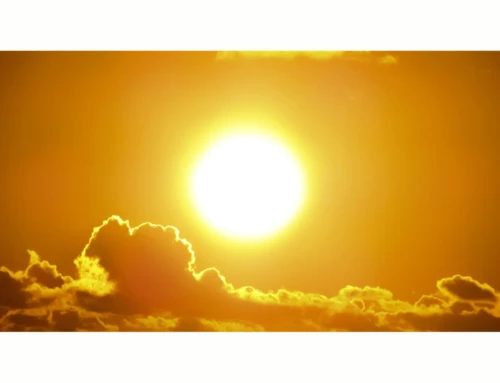Earth is 8,000 miles (12,800 Kilometres) in diameter and 93,000,000 miles (148,800,000 Kilometres) away from the sun. We receive only 1/2,000,000,000 or .00000005 of 1% of the sun’s energy. However, every breeze, tornado, lake-effect snowstorm or balmy fall evening can be traced to the effect of the sun’s energy on our atmosphere.
Small, shifting currents of air acting as many concave lenses or mirrors bend the incoming starlight causing the light to strike or miss our eyes. To us the stars appear to twinkle. It is no wonder the world’s greatest telescopes are located on high mountain tops in an attempt to get above the most dense atmosphere.
If you could measure the temperature in a deserted region of space, with nothing for light years around, it would be about 2.7 degrees Kelvin (-454 degrees Fahrenheit). Zero degrees Kelvin is ‘absolute zero,’ the point at which molecules have no kinetic energy and therefore stand dead still. The 2.7 degrees figure arises from the microwave background radiation – energy left over from the Big Bang that floods the universe in all directions.
Yes! The old adage of lightning never striking twice in the same place is totally false. Lightning is not limited to a one-bolt action. Many lightning flashes are of a multiple variety and may strike repeatedly in a few seconds. Up to 22 consecutive lightning strokes have been observed in a multiple flash. The top of the Empire State Building in New York City is often hit several times during a severe thunderstorm.
Strangely enough Yes ! Chirping crickets can provide a rather close indication of the air temperature. Begin by counting the number of cricket chirps in a 14-second period, then add forty. The total will equal the air temperature (in Fahrenheit) within one degree three out of four times
When cold air is inhaled, the blood veins or capillaries in the nose constrict. After a short period of constriction the capillaries dilate or expand again naturally. This process encourages the release of mucous from adjacent glands and we end up with a runny nose.
As the visible light rays of the sun pass through our turbulent atmosphere they lose a significant amount of their blue wavelength. Due to minute particles of matter and molecules of air within the atmosphere a larger portion of blue is scattered more than any other colour. This is because the blue waves are the shortest. The scattering process makes the sky take on its characteristic blue colour.
Light from the flash reaches your eyes almost instantly. The sound of thunder travels at only 1,100 feet (335,3 meters) per second. Begin counting seconds from when you see the lightning flash (1001, 1002, 1003, etc.) and stop when thunder is heard. Five seconds is approximately one mile (1.61 kilometres). And, by the way, thunder is seldom heard over 15 miles (24 kilometres) away.
A lightning bolt may be a mile (1.6 kilometres) in length. Thunder is generated from every part of the lightning bolt though the sound may not reach your ears at the same time. This can cause the extended rumbling. Also, mountains, tall buildings and cliffs may reflect or intensify the original thunder producing an extended rumbling thunder sound.
Raindrops are much smaller than we think. They range from 1/100 inch (.0254 centimetre) to 1/4 inch (.635 centimetre) in diameter. The rules of nature don’t allow raindrops to exceed about 1/4 inch because air friction breaks up raindrops when they’re larger.
Not including wind-driven rain, raindrops fall between 7 and 18 miles per hour (3 and 8 metres per second) in still air. The range in speed depends on the the size of the raindrop. Air friction breaks up raindrops when they exceed 18 miles per hour.
No! No matter how cold it gets there is always moisture in the air. We often associate very cold air with no snow because invasions of air from the northern latitudes are generally associated with clearing conditions. This air is very dense and has little room for moisture. On the other hand, we generally associate heavy snows with air just below the freezing mark.
Despite what our eyes are telling us, the white stuff isn’t really white but rather translucent.
When light reflects from the many individual sides of every snowflake, it’s scattered in many directions, diffusing the entire colour spectrum and making it appear white to the human eye.
- The energy in an average one day hurricane could power the United States for three years.
- You can use pine cones to forecast the weather: The scales will close when rain is on the way.
- Eighty-five percent of the people killed by lightning are male.
- The amount of sunlight reaching the earth’s surface is 6,000 times the amount of energy used by all human beings worldwide.
- The total amount of fossil fuel used by humans since the start of civilization is equivalent to less than 30 days of sunshine.
- A single snowstorm can drop 40 million tons of snow, carrying the energy equivalent to 120 atom bombs.
- The biggest clouds are cumulonimbus, climbing up to 9.7 kilometres (6 miles) high and holding up to half a million tons of water.
- Permanent snow and ice cover about 12% (21 million square km’s) of the Earth’s land surface.
- 80% of the world’s fresh water is locked up as ice or snow.
- At any particular time, there are approximately 1,800 thunderstorms occurring in the Earth’s atmosphere.
- The tiny droplets of water that make up fog are so small that it would take seven thousand million of them to make a single tablespoonful of water
If you enjoyed reading this, the please explore our other articles below:



